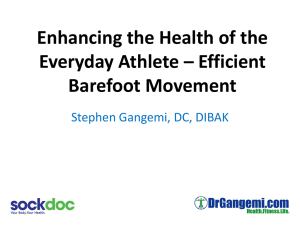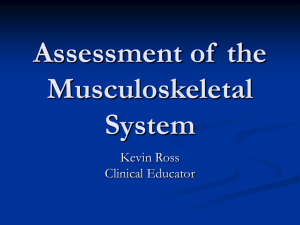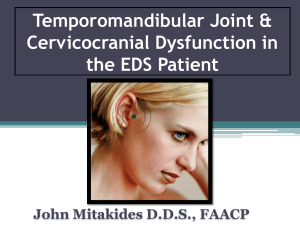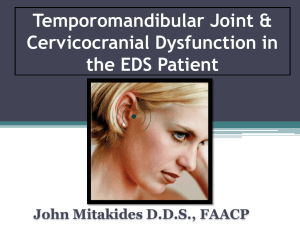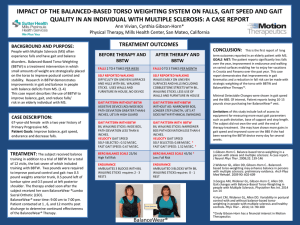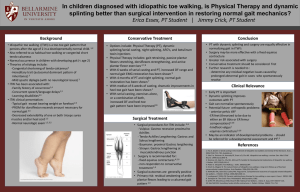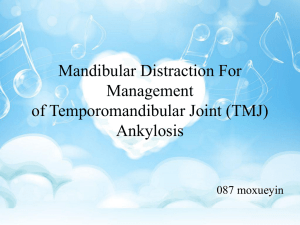The Everyday Athlete – Moving, Eating, & Sleeping
advertisement
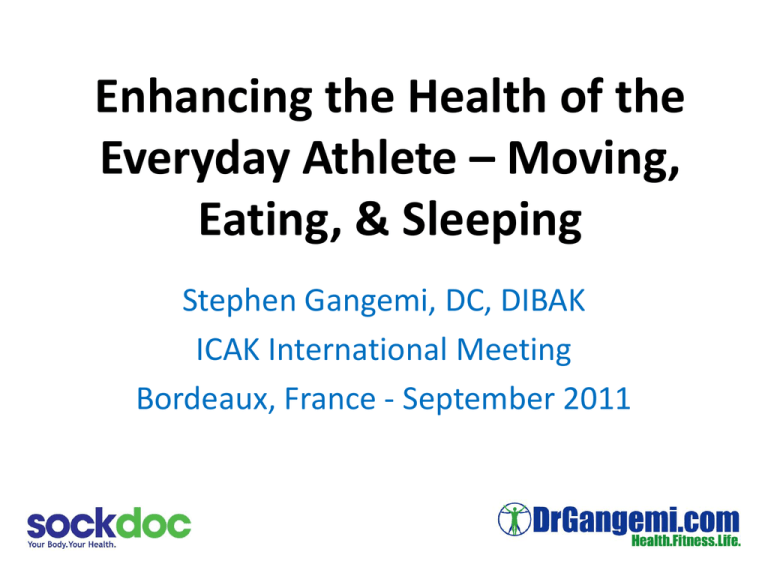
Enhancing the Health of the Everyday Athlete – Moving, Eating, & Sleeping Stephen Gangemi, DC, DIBAK ICAK International Meeting Bordeaux, France - September 2011 Every Patient: • Moves (to some extent) • Eats and drinks • Sleeps (Hopefully) • I will discuss new techniques and therapies you can use to help every patient live a healthier life Moving - Gait • Importance of gait evaluation • Gait dysfunction Health dysfunction • Kinesthetic sense: the relationship between the nervous system and the sensory feedback provided by each foot – 7,000+ nerve endings • Proprioception: sense of position, posture, equilibrium Why Check the Gait? • To restore function • To restore health • So patients don’t “walk themselves back into a problem” What Disrupts Gait? • Those which affect the Triad of Health: – Structural – Nutritional – Emotional • Improper footwear • Orthotics – a brace that supports dysfunction • Nothing worn on the foot can improve its function • A bare foot moves in the most efficient, natural, and healthy way (in a healthy individual) Modern Footwear • Soft midsole Elevated Heel Line of falling weight moves forward with heels Motion Control Footwear Industry Claims • • • • Run faster Jump higher Be stronger Exercise muscles not otherwise used with competitor’s shoes or while barefoot Yet there has never been any research to validate such claims Injury Prevention? • None of which can be substantiated through any scientific study • Numerous studies on injury promotion: – Journal of Injury, Function & Rehabilitation, Dec 2009: Running shoes protect the feet at the expense of increased joint torques at the hip, knee, and ankle – British Journal of Sports Med 2010: Elevated heels and cushioned shoes relationship to injuries – Medicine & Science in Sports & Exercise 1991: Running shoes and diminished sensory feedback and injury increase – More: Runblogger.com, Trtreads.org, philmaffetone.com, sock-doc.com Barefoot or Shod? • Recently, there has been a significant move towards minimalist type shoes and barefoot walking and running • Experienced, habitually barefoot runners will avoid landing on their heel. • The natural motion during barefoot running is to land with a midfoot, or even a somewhat forefoot strike. • A heel strike (while running) most often results in a significant stress to the body, whereas a midfoot or forefoot strike does not • Most running shoes are developed to promote a heel strike, and therefore an unnatural running and gait cycle Heel strike Ideally the body’s center of mass should be over the foot for the lowest loading rate Midfoot/forefoot strike Healthy Footwear • No arch support – the arch needs to flatten upon impact to dissipate shock • Arch supports support the arch, not the ends of the arch a weak and dysfunctional foot Low Stack & Drop • Stack Height 11mm heel • Drop • “Zero-Drop” 11-7=4mm drop 7mm forefoot Shock • No Stability or Motion Control – natural pronation deflects shock • Posterior Tibialis plays an important role Toe Box • No cramped toe box – so the toes can splay apart to soften landing Widest at the toes Cushioning? No! • Cushioning does not absorb shock – it tricks the body by sending false information to the brain – “Is this a soft surface or hard?” The Harder the Surface the Softer the Landing Nice Gait Kid!! • The harder the ground the more the body will adjust with more knee flexion and pronation • Pavement is the easiest to walk/run on barefoot • Natural terrain is unpredictable The Ideal Shoe? • Depends on the individual perform gait test • But generally: •Roomy forefoot (1/3-1/2” in front of big toe) •Close to the ground throughout (low to zero-drop and a low stack height) •Wide Toe Box •Flexible in all directions The New Gait Test To Evaluate Footwear • During normal gait, there is a continuous pattern of facilitation and inhibition • The physician can easily determine a normal and abnormal gait pattern based on manual muscle testing (MMT) General Gait Test – Latissimus Should be Inhibited General Gait Test – Deltoid Should be Inhibited New Addition to Gait Test – Wrist Extensors Should be Inhibited New Addition to Gait Test – Wrist Flexors Should be Inhibited Final New Addition to Gait Test Breathing & the Diaphragm • Check the diaphragm with a full inspiration and expiration, checking for gait distrubance Barefoot Gait Ok? • After testing the patient barefoot, test them: • Standing in their shoes • Standing in their orthotics • Standing in their shoes with orthotics in Barefoot as much as possible, shoes when needed • Using MMT the physician can determine what shoes will not harm the patient during their daily activities and during exercise • Notice that the word “benefit” was not used, as footwear is not meant for this reason • Footwear should only protect the feet from damage that may occur from the particular environment • Transition period into more barefoot walking and minimalisttype shoes as the weakened muscles, tendons, & ligaments regain their strength More on Barefoot, Minimalism, and Injury Prevention & Treatment www.sock-doc.com A more detailed explanation of this gait assessment with more research can be found at www.drgangemi.com under “Research” tab Dysglycemia • Now that your patient is walking about efficiently, how is their diet affecting their performance – both mental and physical? • The TMJ will often reveal hidden blood sugar handling problems which can be easily addressed to improve overall health Temporomandibular Joint (TMJ) • Local tooth and jaw problems • Immune system impairment • Cranial faults • Spinal subluxation • Health distress anywhere in the body • Blood sugar handling problems - Dysglycemia Dysglycemia • Disorder of blood sugar metabolism • Blood glucose reading may be normal • Headaches, feeling shaky, unclear thinking, fatigue, pain, moody, (*tinnitus?) • AK assessment: Latissiumus and triceps not always inhibited The Main Players • Pancreas: Insulin (glucose glycogen) – Glucagon : glycogen glucose (Glycogenolysis) • Adrenal Glands: Cortisol (Lactate, amino acids, glycerol glucose) *Gluconeogenesis – Epinephrine & Norepinephrine (inhibits insulin, stimulates glycogenolysis in the liver and muscles and glycolysis in the muscles) • “Tug of war” between the adrenals and pancreas leads to an increased level of ACTH from the pituitary Adrenocorticotropic Hormone (ACTH) • ACTH – the missing piece to the puzzle of dysglycemia • Barrage of ACTH to the pancreas • Homeopathic ACTH creates a neurological response to the pancreas resulting in an overfacilitation of the pancreas related muscles • Slight rubbing over the pituitary Chapman’s reflex (glabella), will elicit the same response The TMJ’s Involvement With Dysglycemia • Positive TL to left TMJ • Weak muscle strengthens with TL to left TMJ regardless of another muscle, cranial, or immune involvement affecting the TMJ (must fix these first) • Positive TL to right TMJ patient is switched, (neurological disorganization), this must be corrected accordingly • May or may not have jaw or TMJ pain Evaluation & Correction - of the Dysglycemia AND many TMJ Dysfunctions For this… And this… And maybe this too Procedure • Left TMJ TL is positive (strengthens a weak muscle) or TL to left TMJ with head in extension weakens a strong extensor muscle • No change with any jaw movement • Spleen and lower sternum immune involvement is not present or has already been corrected • Right TMJ TL? switched, or some other problem, (such as a local jaw problem),which needs to be addressed Procedure Continued… • ACTH or rubbing pituitary CR weakens both [long head] biceps (over fires the lats and triceps) • TL to left TMJ with the head in extension weakness or ACTH weakening the biceps will be negated by either ATP, glucose, or glycogen, (sometimes thyroid hormone or ribose), as well as TL to the pancreas CR • TL to the pancreas [lateral] CR with ACTH will weaken any strong indicator muscle Correction • Investigate what caused the problem – Diet? • Processed foods/sugars, skipping meals – Offender? • Artificial sweeteners, caffeine, bad fats, food allergies, medications, hormones (cortisol, estrogen) – Nutrient imbalance/deficiency? • Used up during metabolism of glucose/glycogen and stress on organs – Making ATP Correction Continued… DIET • Patient will strengthen with sugar (sucrose, not fructose), glucose, and/or glycogen – Obviously a patient like this does not need more refined sugar, but due to their dysglycemia and continuous blood sugar swings they will test positive for it • Cortisol often the offender • Glycogen stores could be depleted from a low carbohydrate diet or prolonged heavy exercise • More carbohydrates; eat more often? Correction Continued… COMMON OFFENDERS • • • • • • • • • • Cortisol Trans fats Food allergies Caffeine Another hormone besides ACTH Ammonia toxicity Neurotransmitters Medications Excitatory chemical/neurotransmitter such as MSG, homocysteine, aspartic acid/Aspartame Heavy metals Correction Continued… NUTRIENT IMBALANCES OR DEFICIENCIES • Nutrients to effectively make ATP: (B1, B2, B3, B5, B6, Mg, Zn, Mn, Biotin, Lipoic Acid) • To make glycogen: (B6 (P-5-P), Mg, Ca) • Check for COQ10 as it is the main component in the electron transport chain – 500 to 1500mg of COQ10 a day may be necessary for short durations • Thyroid helps modulate the CAC Correction Continued… • Treat the pancreas CR (parasympathetic activity – rubbing) with offender, (unless the thyroid has been shown to need treatment) • Use ACTH if no specific offender can be found • Counsel patient on diet, especially if the pattern reoccurs • Once corrected, TL to the left TMJ should be negative and ACTH or glabella stimulation should not weaken the biceps • No need to be constantly performing the painful origin-insertion technique on the ptygeroid muscles over and over again! Tinnitus & Dysglycemia? • Link between the TMJ and the auditory system is evident by way of the discomallear ligament- ligamentous structure connecting the malleus in the tympanic cavity to the articular disc and capsule of the TMJ • Study in 1992 found that 19 of the 20 subjects had “one or more clinical, electromyographic, and radiographic indications of a temporomandibular disorder”, yet all were completely asymptomatic • Other studies have shown that tinnitus can be a primary or secondary complaint of TMJ disorders • October 2008, the International Journal of Oral & Maxillofacial Surgery published a study suggesting that “extreme stretching of the condyle in conjunction with the ligaments between the ossicles of the inner ear and the TMJ could be the reason for unexplained otological problems Lifestyle Adjustments to Resolve Dysglycemia • • • • • • • Aerobic exercise Eat every few hours Reduce or eliminate refined foods High protein and good quality fats Remove offenders Monitor stress levels Sleep… Time to Sleep Hopefully like this And not like this… Or this… Or because of this Nocturnal Dysglycemia • A major reason for a restless night of sleep • Abrupt changes in glucose levels most often due to increased stress hormones cortisol and epinephrine • ↓ Melatonin (Stress) Hormones • Cortisol – adrenal cortex – Glucose from other substrates – most often protein catabolism (gluconeogenesis) – Liver • Epinephrine (and NE) – adrenal medulla – Glycogen into glucose (glycogenolysis) – Liver and muscles Adrenal Hormones Liver Stress • Liver related muscles: pec sternals & rhomboids • Liver horary period 1am-3am Procedure 1. 2. 3. 4. 5. Test a liver related muscle, (rhomboid or pectoralis major sternal division) – muscle needs to be strong Patient closes the eyes and slowly rolls them in either direction,(REM sleep), weak doctor must address this first Patient’s eyes open, challenge with cortisol by using either oral nutrient testing of homeopathic 6X cortisol or vigorously rubbing the adrenal CRs for 2-3 sec weak cortisol burdening the liver If neither test shows a problem, test simultaneously, (cortisol with REMs) weak nocturnal gluconeogenesis – No weakness in #3 or #4, then: Perform #3 and #4 again substituting epinephrine homeopathic or having the patient clench their fists hard for 2-3 sec #3 weak epinephrine burdening the liver; #4 weak nocturnal glycogenolysis Treatment • Investigate common offenders (remove the cortisol or epinephrine homeopathic if used and perform the REMs test substituting the suspected offender – – – – – Caffeine Sugar Food allergies/intolerances Medications Other hormones • estrogen, testosterone, thyroxine – Emotional stress (patient should therapy localize to the stomach neurovascular points) Treatment Continued… Supplementation & Dietary Advice • Cortisol identified as the problem: • B1, B2, B3, B5, Phosphatidylserine, choline,vitamin E, vitamin C, and magnesium • Protein! Treatment Continued… Supplementation & Dietary Advice • Epinephrine identified as the problem: • B2, B5, B12, selenium, zinc, glucuronic acid, cysteine, glutathione, and copper. • Carbohydrates! Honey Treatment Continued… • Address any emotional or dietary problems identified during the nocturnal dysglycemia testing • Dietary suggestions: – Protein: 1.5g-2.0g/kg bodyweight per day; 20-25g of protein approx. 30 mins prior to bed – Carbohydrates: eat regularly throughout the day, low glycemic carbs Address Other Sleep Factors In Summary… Proper footwear throughout the day (or no footwear) A healthy diet and proper supplementation throughout the day Restful sleep Your energy efficient patient – walking, eating, & sleeping better than ever before More Questions, Information & Research Papers • My email: drgangemi@gmail.com • Websites: drgangemi.com sock-doc.com • Thank you for your attention
